Optical Weaving
September 2019.
"Optical Weaving" led by Linda Wilson was started on the 15th September 2019 as a six-week workshop looking at the ways a handweaver can create illusions, depth and movement based on colour and woven structure. Log Cabin, Shadow Weave and the illusion of Iridescence were the structures and techniques explored in this workshop.
For each assignment, participants could choose one of three options that would work best for them and this catered for all levels of weavers – Beginners (4 shafts); Intermediate (4 shafts); and more Advanced (8 shafts).
With inspiration that could come from anywhere, where you live; an object, colour charts, books or internet, participants were encouraged to select their yarns for warp and weft. The colour choices for the warp and weft yarns needed to have strong contrasting values to create the illusion of depth with Log Cabin and Shadow Weave threadings. As colour played an important role and to assist participants with their colour choices, some basic information on colour theory was given together with the suggestion of viewing your inspiration and yarns in black and white photos to check their value.
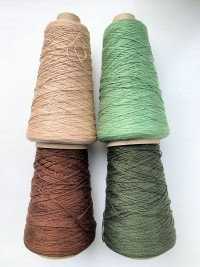
Juliet Lane from Shrewsbury, found some inspiration for her colour choices for the optical weaving, from a photo of the Shropshire countryside in England that she had taken a few weeks earlier, with weaving in mind. Juliet found four colours from her extensive stash of 5/2 mercerised cotton that reflected the fields and wooded areas. Beige and Dark Green in the warp and the Dark Brown and Light Green will be the tints and tones.
Log Cabin samples
When woven in the traditional manner, log cabin uses dark and light colours to achieve the illusion of a complicated cloth. Both warp and weft threads only go over one thread and under one thread. In other words, it is woven in plain weave and it is the arrangement of colour in the warp and weft that creates the complex look of the cloth.
Juliet’s first sample, including a close-up, same colour in weft as warp. Juliet says “The dark green looks almost black in the photos but it really shows up the ‘optical’ illusion, giving depth to the blocks”...
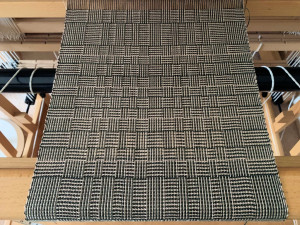
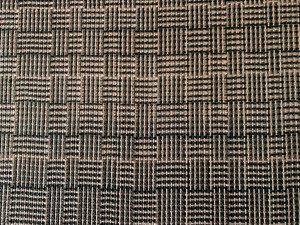
It looks like Pat Griffiths (Ceredigion, Mid Wales) had fun experimenting with several colours in her Log cabin colour sample and created some interesting results with the original colours in warp of terracotta and cream. Pat says, "I started with quite small changes but then got much bolder”.
Pat - Log cabin colour experiments.
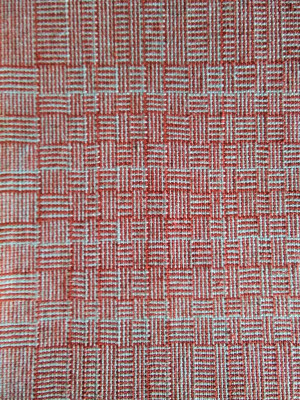
Nelly de Bruijn (Gelderland, The Netherlands) created a Log Cabin sample using yarns to reflect the inspiration of Winter-Autumn-Summer. Below is a close-up of the sample using tints and tones of the warp yarns. to the right is the completed piece.
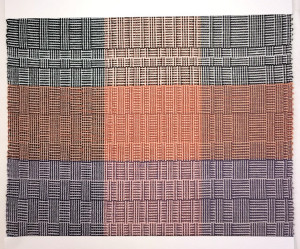
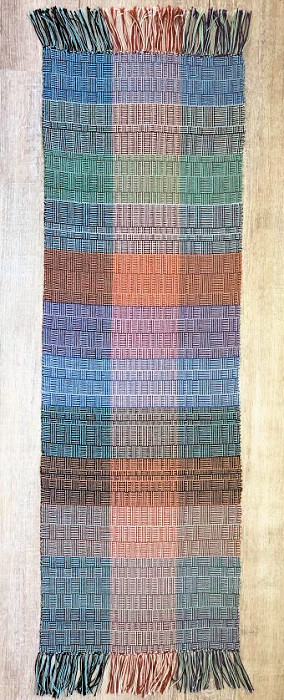
Shadow Weave samples
Shadow Weave is like Log Cabin using two contrasting colours and they alternate in both the warp and weft. However, unlike log cabin, shadow weave is not strictly plain weave and threads can go over more than one end. The arrangement and differing size of blocks in the threading and treadling can be used to depict movement. With the three assignment options available to participants in the workshop, a variety of samples were produced on 4 and 8 shafts.
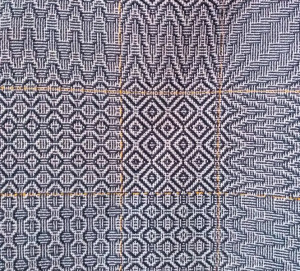
A Shadow weave Gamp by Carol Hunter (from Canada)
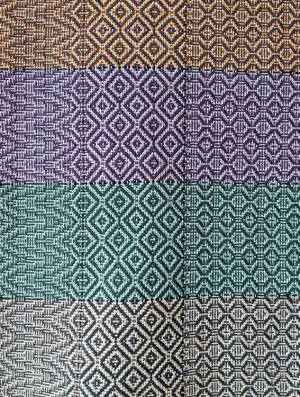
and her Shadow weave colour Gamp.
Carol used Dark Blue and Light Blue as her warp colours and her first gamp has the same yarns in her weft. Carol commented on her colour sample saying “I love the richness of colour I got using different colours in the weft. The two-tone blue gamp looks rather dull in comparison.”.
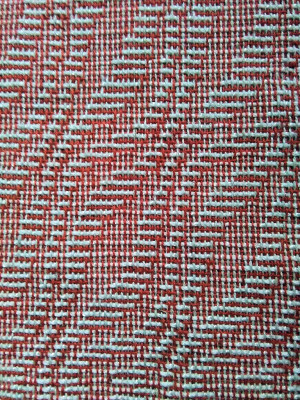
Pat Griffiths shadow weave sample is effective using the same coloured yarns in the weft as the warp but with a thicker beige weft yarn.
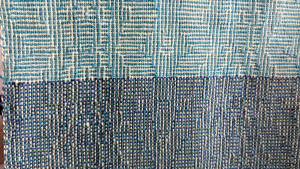
Helen Halpin’s shadow weave sample. Helen from Australia, experimented with a new treadling and different weft yarns, top part warp and weft yarns are the same with the second part of the sample with different colours in the weft.
Iridescence samples
To create the iridescence samples, consideration was required of the lustre of the yarn, colour selection, weave structure and set. The colour selection needed to include a red, blue, green and yellow or a colour that contained these colours. The order of the colours had to be: Yellow, Blue, Green, Red. To show the contrast and value of the colours, instructions were provided on how to do yarn wrappings and photographs of these wrappings in grey scale were effective to obtaining successful colour combinations for iridescence. It needs to be noted that it is difficult to photograph the iridescence effect. Linda Wilson from Vancouver Island BC Canada, posted a photo of a scarf she had woven which she said was very iridescent.
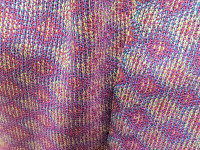
Linda’s iridescence scarf
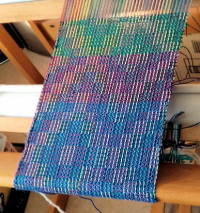
Pat Griffith’s 4 shaft Iridescence
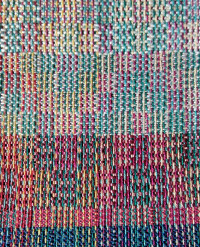
Pat’s 2nd sample using a variety of wefts, including pink ribbon.
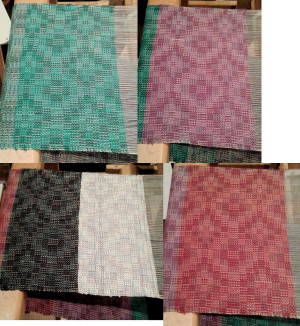
Katy from the Channel Islands created a 4 shaft sample using silk weft to create the different effects.
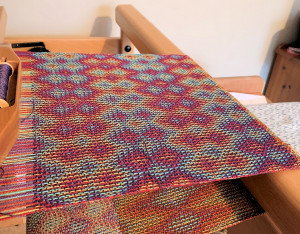
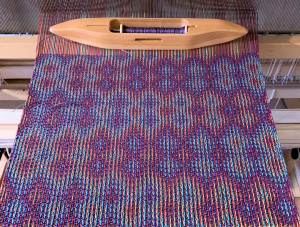
Juliet Lane’s iridescence samples using the 8-shaft version.
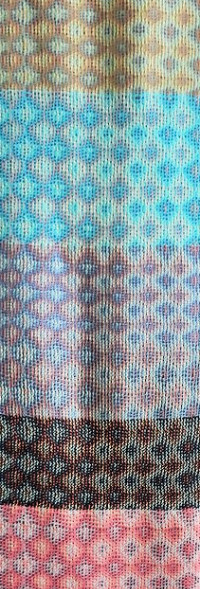
Helen Halpin’s final piece for Iridescence .
The samples for the 8 shaft option used the draft on page 52 of Marian Stubenistsky’s book “Weaving with Echo and Iris”.
And a surprise piece from the workshop - Heather A from the Manitoba Prairie, participated in the workshop applying the principles to felt. She created a successful sample using four colours and creating depth. Margaret describes this interesting sample, ‘I have done my final sample using a pink felted "loom" with purple wefts made of one lilac-dyed fleece with some pink silk blended into it and then felted. I cut the rectangle to make a long weft strip and then wove it into the pink warps. After puzzling over how to put in two more colours the only answer seemed to be to turn the sample and weave two different coloured yarns as if they were warps’.
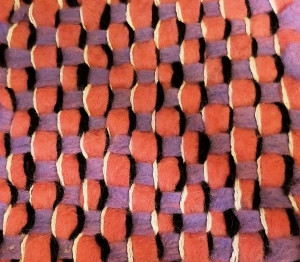
Final comments
This was a well-run workshop with great notes and instructions from Linda. Participants could work at their own pace or try to follow the weekly schedule. However, Linda did schedule time to catch up in Week 5 or suggestions for further samples that could be undertake from the log cabin or shadow weave structures. Messages from participants and Linda came in daily and were very encouraging and friendly. It soon became obvious that it was an international group with participants from England, Channel Islands, Canada, USA, Wales, Holland and Australia.
Linda’s comments in the final week sum up Optical Weaving very well “Hopefully you can see what a marvellous tool colour and the placement of the colours can be. The variety of combinations enables us to produce a variety of optics. Some will produce depth, some movement, and some totally change the colours we see in the cloth”.
